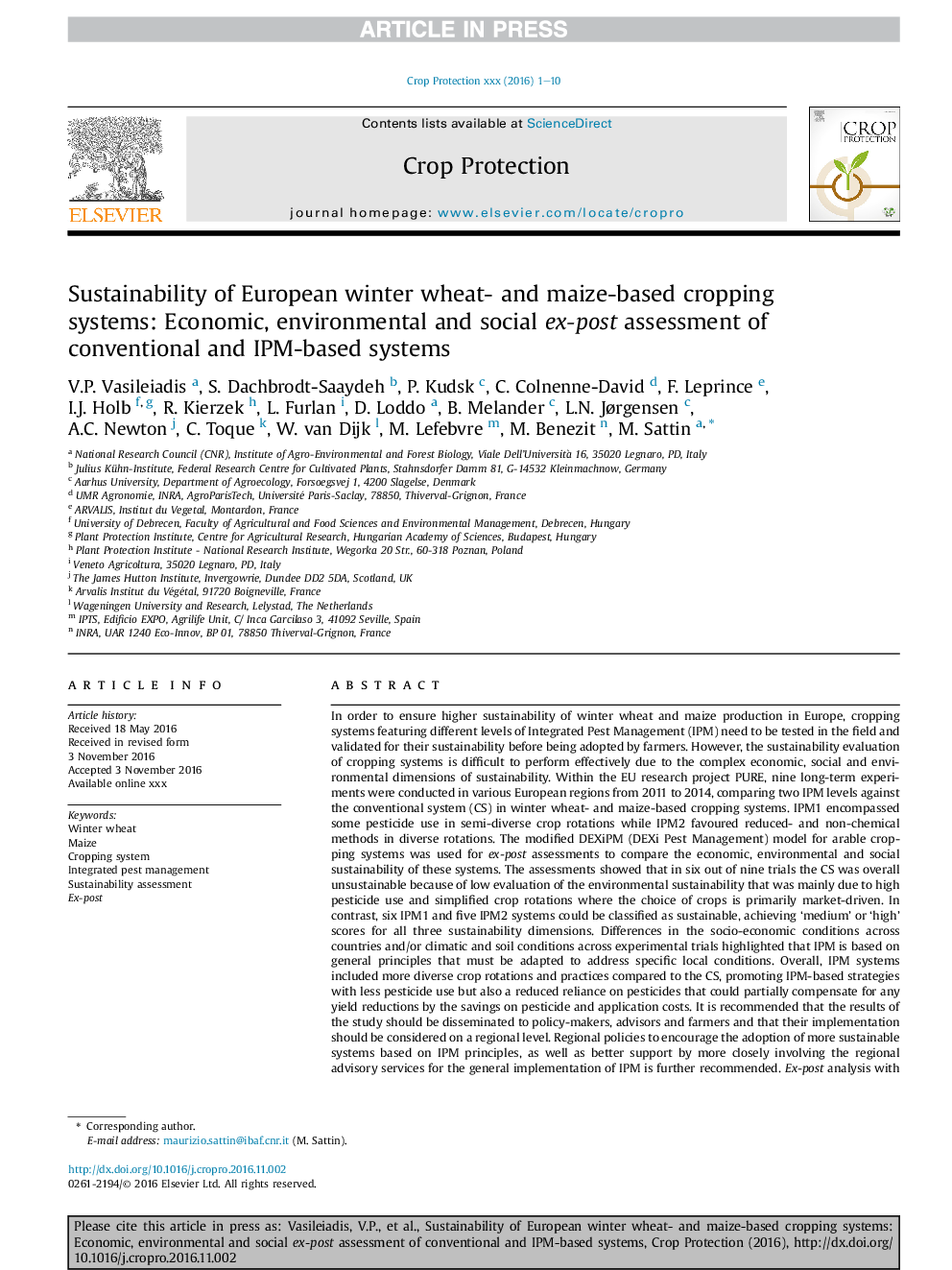| کد مقاله | کد نشریه | سال انتشار | مقاله انگلیسی | نسخه تمام متن |
|---|---|---|---|---|
| 5760862 | 1624290 | 2017 | 10 صفحه PDF | دانلود رایگان |
عنوان انگلیسی مقاله ISI
Sustainability of European winter wheat- and maize-based cropping systems: Economic, environmental and social ex-post assessment of conventional and IPM-based systems
دانلود مقاله + سفارش ترجمه
دانلود مقاله ISI انگلیسی
رایگان برای ایرانیان
کلمات کلیدی
موضوعات مرتبط
علوم زیستی و بیوفناوری
علوم کشاورزی و بیولوژیک
علوم زراعت و اصلاح نباتات
پیش نمایش صفحه اول مقاله

چکیده انگلیسی
In order to ensure higher sustainability of winter wheat and maize production in Europe, cropping systems featuring different levels of Integrated Pest Management (IPM) need to be tested in the field and validated for their sustainability before being adopted by farmers. However, the sustainability evaluation of cropping systems is difficult to perform effectively due to the complex economic, social and environmental dimensions of sustainability. Within the EU research project PURE, nine long-term experiments were conducted in various European regions from 2011 to 2014, comparing two IPM levels against the conventional system (CS) in winter wheat- and maize-based cropping systems. IPM1 encompassed some pesticide use in semi-diverse crop rotations while IPM2 favoured reduced- and non-chemical methods in diverse rotations. The modified DEXiPM (DEXi Pest Management) model for arable cropping systems was used for ex-post assessments to compare the economic, environmental and social sustainability of these systems. The assessments showed that in six out of nine trials the CS was overall unsustainable because of low evaluation of the environmental sustainability that was mainly due to high pesticide use and simplified crop rotations where the choice of crops is primarily market-driven. In contrast, six IPM1 and five IPM2 systems could be classified as sustainable, achieving 'medium' or 'high' scores for all three sustainability dimensions. Differences in the socio-economic conditions across countries and/or climatic and soil conditions across experimental trials highlighted that IPM is based on general principles that must be adapted to address specific local conditions. Overall, IPM systems included more diverse crop rotations and practices compared to the CS, promoting IPM-based strategies with less pesticide use but also a reduced reliance on pesticides that could partially compensate for any yield reductions by the savings on pesticide and application costs. It is recommended that the results of the study should be disseminated to policy-makers, advisors and farmers and that their implementation should be considered on a regional level. Regional policies to encourage the adoption of more sustainable systems based on IPM principles, as well as better support by more closely involving the regional advisory services for the general implementation of IPM is further recommended. Ex-post analysis with DEXiPM also identified the constraints of the IPM1 and IPM2 systems evaluated as not sustainable. These were related to i) environmental issues for those IPM1 systems that still relied mainly on pesticide use and had less diverse crop rotations, and ii) economic issues for IPM2 systems, mainly due to the choice of less profitable crops in the rotation, as well as to yield penalties caused by the very low pesticide use or replacing pesticides with less effective non-chemical methods. The identification of these constraints is a valuable input to the local and regional discussion on how to adopt IPM and develop more sustainable cropping systems.
ناشر
Database: Elsevier - ScienceDirect (ساینس دایرکت)
Journal: Crop Protection - Volume 97, July 2017, Pages 60-69
Journal: Crop Protection - Volume 97, July 2017, Pages 60-69
نویسندگان
V.P. Vasileiadis, S. Dachbrodt-Saaydeh, P. Kudsk, C. Colnenne-David, F. Leprince, I.J. Holb, R. Kierzek, L. Furlan, D. Loddo, B. Melander, L.N. Jørgensen, A.C. Newton, C. Toque, W. van Dijk, M. Lefebvre, M. Benezit, M. Sattin,